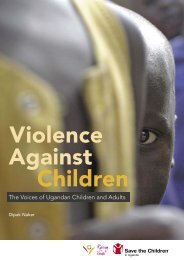2011 Annual Report - Raising Voices
2011 Annual Report - Raising Voices
2011 Annual Report - Raising Voices
You also want an ePaper? Increase the reach of your titles
YUMPU automatically turns print PDFs into web optimized ePapers that Google loves.
manage day-to-day program needs whileCo-Directors focus on demands within thebroader field. Developing managementsystems and continuing to improve adaptiveleadership approaches will be critical tomanaging <strong>Raising</strong> <strong>Voices</strong>’ growth.GBV Prevention Network,<strong>Raising</strong> <strong>Voices</strong>’ Role asthe Coordinating Office<strong>Raising</strong> <strong>Voices</strong> established the GBV PreventionNetwork in 2003 which we continue to coordinateand host. Results from the external evaluationconducted in <strong>2011</strong> reveal that overall,members felt the Network added value totheir work in GBV prevention by increasingaccess to resources and quality materials, andproviding opportunities to make connectionswith others in the field of GBV prevention.90% of respondents also felt that <strong>Raising</strong><strong>Voices</strong> is effective in coordinating the Network’smultiple components, implementingrelevant and useful activities and providingstrategic direction. They perceived our biggeststrength as the Coordinating Office to be ourcommunication, responsiveness to members,and openness to feedback and suggestions.Most participants suggested hiring additionalstaff for the GBV Prevention Network. Todownload the full report or report summary,please visit:www.preventgbvafrica.org/about-networkProgram MonitoringEach program engaged in rigorous monitoringof its activities using methods and toolswhich we have created and when necessary,triangulating with other sources, such as forthe VAC Media Campaign. Monitoring violenceprevention is still an emerging discipline,with few existing resources and littleprecedent of proven methods. Therefore,we have worked hard to develop effective,relevant, and user-friendly tools in order tomonitor both our progress and impact inkey program areas. We have learned a greatdeal in the process and continually revise ourmethods. Our monitoring has been valuablenot only for informing our own programming,but for generating broader learning for thefield which can influence practice and help tocreate stronger evidence-based programmingin the future. For detailed information aboutprogrammatic impact and progress, pleasesee the “Results” section.In <strong>2011</strong>, key monitoring activities included:• Rapid Assessment Survey (RAS) in SASA!communities: The RAS showed statisticallysignificant shifts in key indicator areas relatedto knowledge, attitudes, and behaviorsaround violence against women. For example,63.9% of women and 94.4% of men inintervention communities replied that if ahusband told his friends that he makes decisionsjointly with his wife, his friends wouldrespect him compared to 34.3% of womenand 69.4% of men in control communities.This illustrates that SASA! is positively impactingcommunities as intended in many ways.• Media Campaign research: The VACdepartment undertook two monitoringstudies and commissioned an independentresearch group to assess the effect of themedia campaign in Western, Central andEastern regions of Uganda. It was necessaryto employ the services of a professionalmedia research group (Synovate) in orderto gain a credible understanding of howmany people our campaign reached, howit reached them, how they processed theinformation, and how they pass on whatthey’ve seen, heard, or thought. As notedin the “Results” section, findings indicatedthat our Media Campaign has been highlyeffective in starting a widespread dialogueon VAC in Uganda.• Preparation for the Good Schools study:Despite initial problems getting off theground, efforts are now under way to identifya new research partner and begin thestudy in 2012.In <strong>2011</strong>, the VAC department commissionedfour separate studies in Central, Western andEastern Uganda, interviewing 454 individualsto assess reach and perception of the VACmedia campaign. According to the studies,40% percent of those who claimed that theyhad heard or seen something about violenceagainst children identified it as originatingfrom <strong>Raising</strong> <strong>Voices</strong>. More than two-thirdsof the individuals who had encountered thecampaign stated that they agreed with thekey themes of the campaign. More than halfof those who recognized <strong>Raising</strong> <strong>Voices</strong> couldrepeat back the key idea of the campaign orthe tagline of the info-spots. This suggeststhat we have now developed a loyal audienceacross the country who are regularly tuninginto our campaign.32 <strong>Raising</strong> <strong>Voices</strong> <strong>Annual</strong> <strong>Report</strong> <strong>2011</strong> Preventing Violence Against Women and Children <strong>Raising</strong> <strong>Voices</strong> <strong>Annual</strong> <strong>Report</strong> <strong>2011</strong> Preventing Violence Against Women and Children 33
















